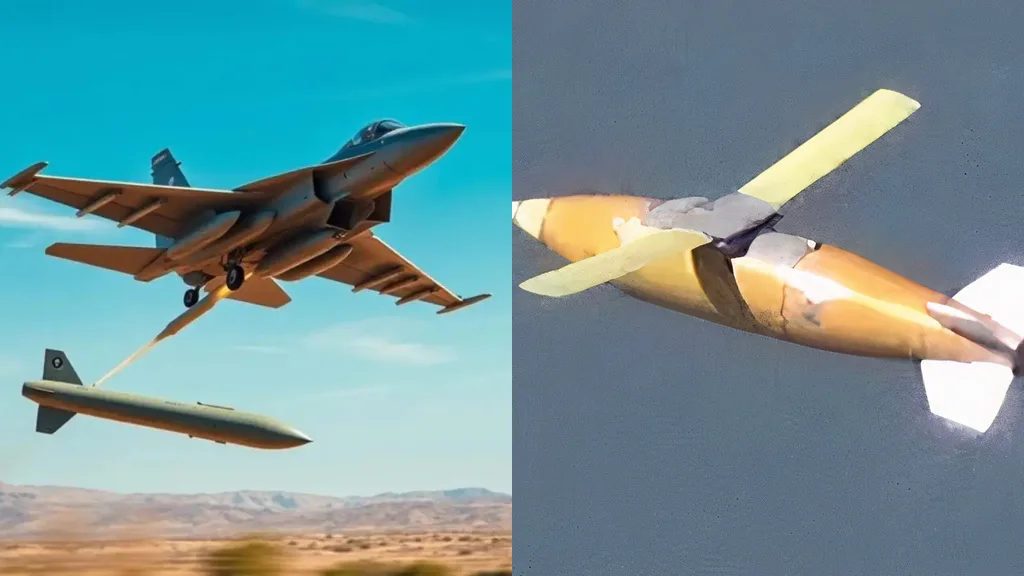India has made a significant stride in enhancing its defence capabilities. The country successfully conducted release trials of the Long-Range Glide Bomb (LRGB) ‘Gaurav’.
The trials took place from April 8 to 10, 2025. This event marks a crucial advancement in Indigenous defence technology. It also highlights India’s commitment to self-reliance in defence manufacturing. This achievement strengthens India’s position in the global defence landscape.
Successful Trials and Pinpoint Accuracy
DRDO’s Accomplishment
The Defence Research and Development Organisation (DRDO) conducted the trials. They used a Su-30 MKI aircraft for these tests. During the trials, the LRGB ‘Gaurav’ was integrated into multiple stations.
It was configured with various warheads. The target was a land area on an island. This integration demonstrated the weapon’s adaptability to different mission needs.
Precision and Effectiveness
The weapon demonstrated a range of nearly 100 kilometers. It also showed remarkable precision. The trials confirmed its ability to strike targets with pinpoint accuracy.
This underscores its potential effectiveness in real-world scenarios. Such accuracy is vital in modern warfare. Minimizing collateral damage and ensuring mission success are paramount.
Advanced Engineering
The success of these trials highlights the advanced engineering. It also reflects the technological sophistication in the development of the LRGB ‘Gaurav.’

What is the ‘Gaurav’ Indigenous Long-Range Glide Bomb?
Definition and Purpose
The LRGB ‘Gaurav’ is a 1,000 kg class glide bomb. It is designed for long-range strikes. After launch, it navigates using a hybrid system.
This system combines INS (Inertial Navigation System) and GPS data. This ensures accurate targeting, even in challenging environments.
Key Features
It offers a significant standoff capability. The launch aircraft can stay safe from enemy targets. This reduces the risk of detection and engagement.
The LRGB ‘Gaurav’ can be integrated with multiple warhead configurations. This allows adaptation to different mission requirements.
Indigenous Design and Development
Collaborative Efforts
The LRGB ‘Gaurav’ is indigenously designed and developed. This was done by premier Indian defence entities.
The Research Centre Imarat, the Armament Research and Development Establishment, and the Integrated Test Range, Chandipur were all involved. These institutions used their expertise to create the weapon. It meets the specific needs of the Indian Armed Forces.
Technology Protection
The indigenous design ensures technology protection. It allows for further development and adaptation. The involvement of multiple research centers fosters collaboration. This drives innovation and ensures a robust, reliable final product.
Public-Private Partnerships
The development involved collaborative efforts. The system was realized with support from Development-cum-Production Partners. These include Adani Defence Systems & Technologies, Bharat Forge, and numerous MSMEs.
These partnerships unite public and private sector expertise. This creates synergy and accelerates the production of advanced defence technologies. The involvement of MSMEs promotes entrepreneurship and innovation at the grassroots level.
Atmanirbhar Bharat Initiative
This collaboration underscores the importance of public-private partnerships. It advances India’s defence capabilities under the Atmanirbhar Bharat initiative.
This initiative aims to reduce India’s dependence on foreign imports and increase Indian defence exports. It promotes domestic manufacturing. By fostering collaboration, India builds a robust, self-reliant defence ecosystem.
Technical Specifications and Advanced Features
Hybrid Navigation System
The LRGB ‘Gaurav’ features an advanced hybrid navigation system. It combines INS and GPS data. This ensures accurate targeting in challenging environments.
Long-Range Capability
The glide bomb’s design enables long-distance coverage. This provides a significant standoff capability. Launch aircraft can remain at a safe distance from enemy targets. This reduces detection and engagement risks.
Versatile Integration
The LRGB ‘Gaurav’ is designed for integration with multiple warhead configurations. This allows adaptation to different mission requirements. This versatility makes it a valuable addition to the Indian Air Force’s arsenal.
Strategic Implications and Future Prospects
Enhanced Capabilities
The successful trials have significant strategic implications. The glide bomb’s ability to strike targets at long distances enhances the Armed Forces’ capabilities. This is crucial for addressing threats and securing India’s borders.
Self-Reliance
The indigenous design reduces dependence on foreign sources. This aligns with the nation’s self-reliance goals. Self-reliance is essential for maintaining strategic autonomy. It ensures India has the capabilities to protect its interests.
Induction into IAF
The trials are paving the way for the weapon’s induction into the Indian Air Force (IAF). The Centre for Military Airworthiness & Certification and the Directorate General of Aeronautical Quality Assurance contributed to the process. This rigorous testing ensures the LRGB ‘Gaurav’ meets high standards. The induction will significantly enhance the IAF’s operational capabilities.
Broader Implications
The development has broader implications for India’s defence industry. It demonstrates growing capabilities in advanced defence technologies. India can compete with leading global players. This success will likely attract further investment and innovation. It will create new opportunities for growth and development.
Conclusion
The successful development and testing of the (LRGB) ‘Gaurav’ Indigenous Long-Range Glide Bomb is a major milestone. It showcases India’s growing capabilities in Indigenous defence technology. It also highlights the commitment to enhancing national security.
The collaborative effort between DRDO, IAF, and private industries exemplifies the spirit of Atmanirbhar Bharat. This promises a stronger, self-reliant defence ecosystem for India. It contributes to economic growth and technological advancement. It positions India as a major global player.
Learn more at DefenceNewsIndia.in – your trusted source for updates on India’s defense, aerospace, and strategic innovations.
